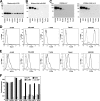Old World and clade C New World arenaviruses mimic the molecular mechanism of receptor recognition used by alpha-dystroglycan's host-derived ligands
- PMID: 17360738
- PMCID: PMC1900301
- DOI: 10.1128/JVI.02574-06
Old World and clade C New World arenaviruses mimic the molecular mechanism of receptor recognition used by alpha-dystroglycan's host-derived ligands
Abstract
alpha-Dystroglycan (DG) is an important cellular receptor for extracellular matrix (ECM) proteins and also serves as the receptor for Old World arenaviruses Lassa fever virus (LFV) and lymphocytic choriomeningitis virus (LCMV) and clade C New World arenaviruses. In the host cell, alpha-DG is subject to a remarkably complex pattern of O glycosylation that is crucial for its interactions with ECM proteins. Two of these unusual sugar modifications, protein O mannosylation and glycan modifications involving the putative glycosyltransferase LARGE, have recently been implicated in arenavirus binding. Considering the complexity of alpha-DG O glycosylation, our present study was aimed at the identification of the specific O-linked glycans on alpha-DG that are recognized by arenaviruses. As previously shown for LCMV, we found that protein O mannosylation of alpha-DG is crucial for the binding of arenaviruses of distinct phylogenetic origins, including LFV, Mobala virus, and clade C New World arenaviruses. In contrast to the highly conserved requirement for O mannosylation, more generic O glycans present on alpha-DG are dispensable for arenavirus binding. Despite the critical role of O-mannosyl glycans for arenavirus binding under normal conditions, the overexpression of LARGE in cells deficient in O mannosylation resulted in highly glycosylated alpha-DG that was functional as a receptor for arenaviruses. Thus, modifications by LARGE but not O-mannosyl glycans themselves are most likely the crucial structures recognized by arenaviruses. Together, the data demonstrate that arenaviruses recognize the same highly conserved O-glycan structures on alpha-DG involved in ECM protein binding, indicating a strikingly similar mechanism of receptor recognition by pathogen- and host-derived ligands.
Figures






Similar articles
-
O Mannosylation of alpha-dystroglycan is essential for lymphocytic choriomeningitis virus receptor function.J Virol. 2005 Nov;79(22):14297-308. doi: 10.1128/JVI.79.22.14297-14308.2005. J Virol. 2005. PMID: 16254364 Free PMC article.
-
Posttranslational modification of alpha-dystroglycan, the cellular receptor for arenaviruses, by the glycosyltransferase LARGE is critical for virus binding.J Virol. 2005 Nov;79(22):14282-96. doi: 10.1128/JVI.79.22.14282-14296.2005. J Virol. 2005. PMID: 16254363 Free PMC article.
-
Old World arenavirus infection interferes with the expression of functional alpha-dystroglycan in the host cell.Mol Biol Cell. 2007 Nov;18(11):4493-507. doi: 10.1091/mbc.e07-04-0374. Epub 2007 Aug 29. Mol Biol Cell. 2007. PMID: 17761532 Free PMC article.
-
Receptor binding and cell entry of Old World arenaviruses reveal novel aspects of virus-host interaction.Virology. 2009 May 10;387(2):245-9. doi: 10.1016/j.virol.2009.02.042. Epub 2009 Mar 25. Virology. 2009. PMID: 19324387 Review.
-
Cell entry by human pathogenic arenaviruses.Cell Microbiol. 2008 Apr;10(4):828-35. doi: 10.1111/j.1462-5822.2007.01113.x. Epub 2007 Dec 21. Cell Microbiol. 2008. PMID: 18182084 Review.
Cited by
-
Genome-wide identification of susceptibility alleles for viral infections through a population genetics approach.PLoS Genet. 2010 Feb 19;6(2):e1000849. doi: 10.1371/journal.pgen.1000849. PLoS Genet. 2010. PMID: 20174570 Free PMC article.
-
Large induces functional glycans in an O-mannosylation dependent manner and targets GlcNAc terminals on alpha-dystroglycan.PLoS One. 2011 Feb 9;6(2):e16866. doi: 10.1371/journal.pone.0016866. PLoS One. 2011. PMID: 21347376 Free PMC article.
-
Characterization of Lassa virus cell entry and neutralization with Lassa virus pseudoparticles.J Virol. 2009 Apr;83(7):3228-37. doi: 10.1128/JVI.01711-08. Epub 2009 Jan 19. J Virol. 2009. PMID: 19153226 Free PMC article.
-
The underlying mechanisms of arenaviral entry through matriglycan.Front Mol Biosci. 2024 Mar 7;11:1371551. doi: 10.3389/fmolb.2024.1371551. eCollection 2024. Front Mol Biosci. 2024. PMID: 38516183 Free PMC article. Review.
-
Binding of Lassa virus perturbs extracellular matrix-induced signal transduction via dystroglycan.Cell Microbiol. 2012 Jul;14(7):1122-34. doi: 10.1111/j.1462-5822.2012.01784.x. Epub 2012 Apr 4. Cell Microbiol. 2012. PMID: 22405130 Free PMC article.
References
-
- Ahmed, R., A. Salmi, L. D. Butler, J. M. Chiller, and M. B. Oldstone. 1984. Selection of genetic variants of lymphocytic choriomeningitis virus in spleens of persistently infected mice. Role in suppression of cytotoxic T lymphocyte response and viral persistence. J. Exp. Med. 160:521-540. - PMC - PubMed
-
- Andac, Z., T. Sasaki, K. Mann, A. Brancaccio, R. Deutzmann, and R. Timpl. 1999. Analysis of heparin, alpha-dystroglycan and sulfatide binding to the G domain of the laminin alpha1 chain by site-directed mutagenesis. J. Mol. Biol. 287:253-264. - PubMed
-
- Barresi, R., and K. P. Campbell. 2006. Dystroglycan: from biosynthesis to pathogenesis of human disease. J. Cell Sci. 119:199-207. - PubMed
-
- Barresi, R., D. E. Michele, M. Kanagawa, H. A. Harper, S. A. Dovicio, J. S. Satz, S. A. Moore, W. Zhang, H. Schachter, J. P. Dumanski, and K. P. Campbell. 2004. LARGE can functionally bypass alpha-dystroglycan glycosylation defects in distinct congenital muscular dystrophy. Nat. Med. 7:696-703. - PubMed
Publication types
MeSH terms
Substances
Grants and funding
LinkOut - more resources
Full Text Sources
Molecular Biology Databases
Research Materials

